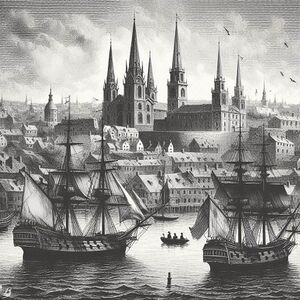Structure of the Royal Arcerion Naval Service
The Structure of the Royal Arcerion Naval Service consists of multiple branches, those being: The Admiralty, Naval Operations Branch, Shore Establishment, and the Fleet.

The organization of the Navy has changed over the centuries and gradually evolved to its current state after the end of the Occidental Cold War and following the Final War of the Deluge. During the First and Second Great Wars, it was organized along the Ardmori tradition, which centred around Battleship, Cruiser, and Destroyer divisions which was each composed of squadrons of ships of the named class. However the end of the Occidental Cold War, and the closer defense relationship with Burgundie has gradually evolved the structure of the Navy towards the Task Force system wherein shops are administratively controlled by squadrons or flotillas, but functionally and operationally assigned to combatant commanders in Task Forces dedicated for a certain mission or operation. By the 1990s and early 2000s, this was the norm and the creation of a Burgoignesc surface warfare school to be attended by Arccer naval officers furthered the changes in doctrine that shaped the changes in the Naval Service.
In modern times, the structure of the Navy can be considered to have the traditions, heraldry, and historical lineage of the Ardmori Navy, but functionally it functions as an offshoot of Burgoignesc naval doctrine and practices.
History

Early Arcer naval organization was a subset of Ardmore's Royal Navy. The ships were assigned to the Arcerion Squadron, the first fledgling formation for warships in the then Ardmore colony of Arcerion. These were joined in conjunction by 'stone ships,' or the shore facilities and ports with naval berthings that supported the actual wooden ships and frigates throughout the end of the 18th century. These forts had shore batteries of naval guns that both protected harbours, such as Kurst and Chester-on-Moore, as well as strategic choke points such as the Warrington Straits or the Innis River Basin. These early institutions would eventually become the nascent beginning of the Royal Arcerion Naval Service.
The Royal Arcerion Naval Service, after its establishment in 1805 organized itself around two squadrons of wooden frigates, as it had no ships-of-the-line (battleships). These two squadrons were each commanded by a Commodore, with a Rear Admiral in command. Concurrently, the shore facilities were also commanded by a Rear Admiral, with overall command of the Arcer Navy as a Vice Admiral. During this period, up until the dissolution of the Ardmore Crown during the Ardmori Civil War, Arcerion would remain under the command of the Ardmori Admiralty. During this period, the Arcer Navy would reorganize into multiple new squadrons. Notably, the Songun and Malentine Squadrons would comprise the initial battle line of the Arcer Navy, numbering roughly a dozen warships. As well, the Riverine Squadron was created to sail a number of the large rivers in Arcerion, as well as organizing a Seaman's School and a Naval Officer Academy in Chester-on-Moore.
By the end of 1800, the Arcer Navy required restructuring due to the number of forts, naval shore batteries, warships, and a growing Admiralty. The establishment of the Arcer Admiralty (eventually amalgamated into the Arcer General Staff) also meant that there had to be a fundamental restructuring of the naval messes and officer education, as most Arcer senior officers were former Ardmori naval officers that had emigrated to Arcerion and used their discharge papers to receive parcels of land from the Arcer Colonial Government and the Crown Governor of Arcerion.
With the introduction of modern per-dreadnought warships, Arcerion also had a major shift in its naval structure during the Ardmori Civil War. With the destruction and dissolution of both the Ardmori Royal Navy as well as the lack of overall command, the Arcer Admiralty reorganized their navy to accomodate the fact that they were now a sovereign nation and not a functional part of the Ardmori Armed Forces. During this period, described as the post-Sovereign period in the Navy's official history, there was a tumultuous amount of change. The Ardmori tradition for the Navy was kept, espcially with regards to the ranks and organization. During this period collaboration began with the Burgoignesc Navy, which would eventually become the Arcer Navy's major partner.
The Ardmori Civil War also identified the need for a dedicated Merchant Marine and a sealift command. The Arcer Ardmiralty created a dedicated transport and supply organization to ensure that men, weapons, and equipment could be sent overseas for expeditionary operations. This was also the period that Arcer doctrine suffered heavily as the Ardmori Navy had traditionally been the blue and green water expertise that Arcerion lacked. However, the large amount of Ardmori expats and the Ardmori diaspora helped as many former members of the Ardmori Navy joined the Arcer Naval Service upon arriving in the colony.
1GW
interwar
2GW
cold war
modern mini burg navy
Administrative
The Admiralty (Headquarters)
Kurst

Shore Establishment
Staff College - Chester
Basic training facilities - Chester
The Fleet
Cronan Bases
Submarines
Frigates/Destroyers
Maritime patrol
SAR
Main naval base
major yards
destroyers, frigates, expeditionary support vessels
maritime patrol
SAR
Overseas Bases
Kurst battlegroup
Planned Base in Republic of Stenza
Formations
Surface squadrons
Air squadrons
Submarines
Special Forces
Radar and AWACS